This is David Loftus's page:
| |
|
|
|
|
|
|
|
By David Loftus
June 24th, 2009
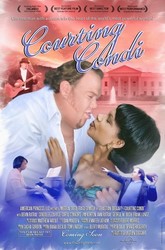 By now, many of us have grown accustomed to films that make us uncomfortable. By now, many of us have grown accustomed to films that make us uncomfortable.
There have been documentaries that showed us unpleasant truths, whether old (“The Fog of Warâ€) or new (“An Inconvenient Truthâ€), and plenty of pop films which thrived on humiliating their heroes (from “There’s Something About Mary†to “Flirting With Disasterâ€) while we laughed and, to a degree perhaps, empathized.
Just when you thought nothing new could be done outside of CGI animation, particularly in the documentary format, here comes “Courting Condi,†dubbed a “musical docu-tragi-comedy†by its makers. Part road picture, part buddy movie, part musical, and yes, part straight documentary at the same time as it’s almost a parody of documentaries, “Courting Condi†is often funny, sometimes downright silly, and occasionally startling as a whack upside the head.
One might also drag out that aging, much-abused term “post-modern†here. But I wouldn’t want you to think there’s anything stuffy or academic about “Courting Condi.†Simply, it’s the “story†of a chubby loser of a young musician who conceives a great love for George Bush’s Secretary of State, and – under the illusion they could somehow meet, date, and end up as soulmates – tracks her life and career from Birmingham, Alabama to Washington D.C. by way of Denver and Palo Alto (Stanford University).
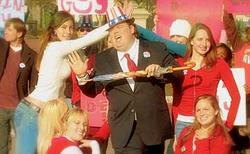 Slowly but surely, it also morphs from a ridiculous shaggy-love tale (our Romeo makes several MTV-style music videos he calls “love disks†and is shown mailing them to his beloved) to the real-life depiction of a good Christian girl (a playmate of one of the four girls killed in the 1963 bombing of the Sixteenth Street Baptist Church in Birmingham) and African-American scholar … who underwent a transformation into a corporate board fixture after whom an oil tanker was named, who enjoyed the assistance of affirmative action but punished and ignored others who did the same, who overlooked civil slaughter in Nigeria and lied about Iraq, and who okayed the torture of Muslim prisoners. Slowly but surely, it also morphs from a ridiculous shaggy-love tale (our Romeo makes several MTV-style music videos he calls “love disks†and is shown mailing them to his beloved) to the real-life depiction of a good Christian girl (a playmate of one of the four girls killed in the 1963 bombing of the Sixteenth Street Baptist Church in Birmingham) and African-American scholar … who underwent a transformation into a corporate board fixture after whom an oil tanker was named, who enjoyed the assistance of affirmative action but punished and ignored others who did the same, who overlooked civil slaughter in Nigeria and lied about Iraq, and who okayed the torture of Muslim prisoners.
What’s especially pomo about the movie is its ploy of putting writer-director-producer Sebastian Doggart inside the story, as a documentary film director who follows the “co-star†– lovestruck Devin Ratray, acting under his own name as well – in pursuit of the title character, who of course never appears on camera by choice but only in archival footage (and as an animated cut-out, among other things).
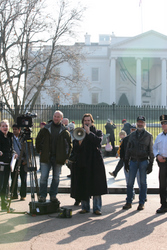 The character of “Doggart†in the film is clearly depicted as being much less intelligent than the real filmmaker (a King’s College, Cambridge graduate in the social and political sciences, and veteran director of stage and TV documentaries on both sides of the Atlantic), just as Ratray (whose acting resume includes Buzz in two “Home Alone†movies and several episodes of “Law and Orderâ€) can’t possibly be as credulous and foolish as he appears in this movie. The climax (or nadir, depending on how you look at it) of their buddy relationship occurs midway through the movie when “Doggart†tries to convince “Ratray†during a beach shoot that the narrative arc demands a nude scene. The character of “Doggart†in the film is clearly depicted as being much less intelligent than the real filmmaker (a King’s College, Cambridge graduate in the social and political sciences, and veteran director of stage and TV documentaries on both sides of the Atlantic), just as Ratray (whose acting resume includes Buzz in two “Home Alone†movies and several episodes of “Law and Orderâ€) can’t possibly be as credulous and foolish as he appears in this movie. The climax (or nadir, depending on how you look at it) of their buddy relationship occurs midway through the movie when “Doggart†tries to convince “Ratray†during a beach shoot that the narrative arc demands a nude scene.
Early on, many viewers are apt to feel an I-can’t-believe-they’re-doing-this discomfort about the romantic premise. We’re being made to watch this loser try to catch the eye of the nation’s first black female Secretary of State, who is nearly twice his age? In the course of interviewing Rice’s childhood neighbors and friends in Alabama, the filmmakers offer a very Michael Moore moment when Ratray attempts to speak to Rice’s mother as she’s trying to get from her car in the driveway to her house and pretty much brushes them off (understandably so).
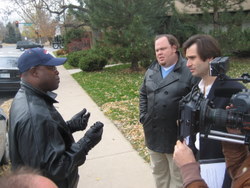 Things start to turn a little weirder – because less obviously farcical and futile – as Ratray and Doggart get Rice’s one and only ex-fiancé, former Denver Broncos receiver Rick Upchurch, to show his engagement ring and reminisce about their dates; then receive romantic advice and potential love songs from Grammy-winning composer and one-time Elvis girlfriend Carol Connors; and then put Devin through the image-making tutelage and focus-group grinder of Frank Luntz, campaign marketing wizard to a string of Republican politicians. Connors and Luntz strut their respective expertises, but they also play for the camera a little, and thereby induce a little extra vertigo in the viewer. Read the rest of this entry » Things start to turn a little weirder – because less obviously farcical and futile – as Ratray and Doggart get Rice’s one and only ex-fiancé, former Denver Broncos receiver Rick Upchurch, to show his engagement ring and reminisce about their dates; then receive romantic advice and potential love songs from Grammy-winning composer and one-time Elvis girlfriend Carol Connors; and then put Devin through the image-making tutelage and focus-group grinder of Frank Luntz, campaign marketing wizard to a string of Republican politicians. Connors and Luntz strut their respective expertises, but they also play for the camera a little, and thereby induce a little extra vertigo in the viewer. Read the rest of this entry »
|
|
|
|
| |
|
|
|
|
|
|
|
By David Loftus
May 6, 2007
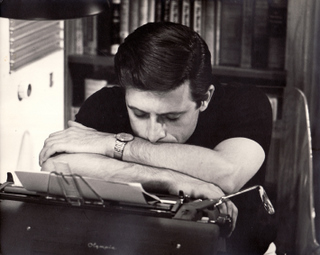 When the screening ended, the crowd leapt to its feet to applaud and cheer the subject of the newly-completed (or rather, nearly-completed) documentary. Characteristically, but good-naturedly, he shouted: “Stop! Stop! I’ll only say something that’ll alienate you later!†When the screening ended, the crowd leapt to its feet to applaud and cheer the subject of the newly-completed (or rather, nearly-completed) documentary. Characteristically, but good-naturedly, he shouted: “Stop! Stop! I’ll only say something that’ll alienate you later!â€
On Thursday, April 19, “Dreams with Sharp Teeth,†a new film by the producers of Werner Herzog’s “Grizzly Man,†received its first public screening at the Writers Guild Theatre in Los Angeles. Read the rest of this entry »
|
|
|
|
| |
|
|
|
|
|
|
|
 Few creatures receive the perennial good press enjoyed by penguins. In popularity as stuffed toys they’re probably right behind teddy bears, dogs, cats, and horses; and cartoonists from Oliphant to Berke Breathed have found them ideal as commentators. Few creatures receive the perennial good press enjoyed by penguins. In popularity as stuffed toys they’re probably right behind teddy bears, dogs, cats, and horses; and cartoonists from Oliphant to Berke Breathed have found them ideal as commentators.
So perhaps it should not have been any great surprise that the documentary crowd pleaser of 2005 turned out to be a nature film, distributed by Warner Independent Pictures and funded by National Geographic, “as told by Morgan Freeman†and “based upon the story by Luc Jacquetâ€â€”whatever that means—that stars emperor penguins. What is surprising is how little we really knew about them, as well as how gorgeous the severely limited palette of Antarctica proved to be for the cameras. Read the rest of this entry »
|
|
|
|
| |
|
|
|
|
|
|
|
Since the topsy-turvy election of 2000, many Americans have puzzled over the question: If George W. Bush is as dumb as he sometimes appears to be, how did he ever become President? Though the 2004 documentary “Bush’s Brain†might not necessarily have the answer, it certainly provides an answer, and a pretty substantial one.
Based on the book by James C. Moore and Wayne Slater, Bush’s Brain: How Karl Rove Made George W. Bush Presidential, and made with their avid cooperation, “Bush’s Brain†is a portrait of Karl Rove, the political consultant behind Bush’s election who apparently has become as heavily involved in Bush administration policymaking—international perhaps even more than domestic—as he was with politicking. Compared to “Fahrenheit 9/11,†the film is fairly restrained in its presentation of a story that is frightening enough in its factual details.
Click here for the full review by David Loftus.
|
|
|
|
| |
|
|
|
|
|
|
|
Conventional wisdom used to have it that an Oscar was worth an extra million dollars in box office receipts. But that was a decade or two ago, and probably applied only to mainstream feature films.
I saw veteran documentary filmmaker Errol Morris’s latest work, “The Fog of War,” two days after it won the 2004 Academy Award for the Best Documentary. There were only three of us in the audience. Granted, it was a mid-afternoon screening on a Tuesday, but still I have to wonder whether that golden statuette will translate into bigger bucks for this film.
Click here to read the full review by David Loftus.
|
|
|
|
| |
|
|
|
|
|
|
|
“Fahrenheit 9/11″ opened with great fanfare across the U.S. on June 26, 2004. It grossed $8 million on opening night, and as I write this, three nights later, news reports peg it as the number one film in the country its first weekend. It broke the record for biggest gross for a film opening on less than 1,000 screens (the record holder was “Rocky”), and had a higher per-screen take than “The Passion of the Christ” on its opening weekend. It remains to be seen whether the initial hue and cry of critics and commentators will inspire or sway the average moviegoer, let alone the electorate. But to have the country buzzing about truth or satire, accuracy or lies, war or regime change (overseas or at home) instead of the latest special effects extravaganza, leather-clad fantasy figure, wizard-in-training, or J. Lo and Marc Anthony, is a welcome change from summers past.
Click here to read the full review by David Loftus.
|
|
|
|
| |
|
|
|
|
|
|
|
Try to picture an art piece that cannot be put in a museum, purchased by wealthy collectors, or displayed in a corporate foyer or boardroom – because it disintegrates in less than a day, perhaps even within 20 seconds. Try to imagine executing artwork through the medium of iron oxide chalk, raw sheep’s wool, flower blossoms, leaves and grass, feathers, random sticks and stones, broken rocks, pieces of icicle, green iris blades and red berries, thorns, bracken, or handfuls of snow. Try to fathom the notion that an artist could a take stroll in the woods, along a riverbank, down a beach, and with no tools at all – no paint brushes, no sculptor’s chisels or knives, no canvases or pedestals or quarried granite or polished wood – manage to create unutterably beautiful art from the objects and materials he finds by chance.
Click here to read the full review by David Loftus.
|
|
|
|
| |
|
|
|
|
|
|
|
It sounds like the title of a Hitchcock movie. (In fact, it was: the 1945 Ingrid Bergman-Gregory Peck psychological thriller.) In reality, more than half a dozen films have carried this title since 1916, but the 2002 “Spellbound†is both more quotidian (“bound by spelling†as well as “headed for the spelling beeâ€) and the most refreshing: It’s about the 1999 Scripps-Howard National Spelling Bee.
Director Jeffrey Blitz and his team follow 8 kids between 10 and 14 as they progress from their respective home towns to Washington, DC for the big one. (They originally shot 13 kids, but narrowed their scope to arrive at a very full 95-minute run time.)
Click here for the full review by David Loftus.
|
|
|
|
| |
|
|
|
|
|
|
|
In the summer of 1970, the year after Woodstock and Altamont, a crazy collection of future legends of rock and roll took a train across Canada, playing (in every sense of the word) en route as well as stopping for concerts in Toronto, Winnipeg, and Calgary.
The Band, The Grateful Dead, Janis Joplin, Buddy Guy, the Flying Burrito Brothers, and a dozen lesser lights sang, drank, and communed across the map between June 27 and July 4, while cameras recorded the escapade. “This was kind of like a traveling circus,†remembers Ken Pearson, a member of Joplin’s band. “It was a train full of insane people careening across the Canadian countryside,†Dead guitarist Phil Lesh recalls. People got very little sleep, Buddy Guy says, “because every time I went to bed I was afraid I was gonna miss something.â€
Click here for the full review by David Loftus.
|
|
|
|
| |
|
|
|
|
|
|
|
A film reviewer for Time magazine since 1972, Richard Schickel has attained the stature of a dean of movie history and criticism. Rather than merely turn in his weekly copy, collect columns in occasional book form, and appear as a guest in other people’s documentaries, Schickel has quietly built a respectable body of studies on film about eminent directors (and more pointedly, writer-directors), as well as a few actors.
Much of this work has been for TV: segments on Hitchcock, Cukor, Hawks, Vidor, Walsh, and Minnelli for the excellent 1973 “documentary miniseries†called “The Men Who Made the Movies,†and more recent projects on Eastwood, Cagney, and Harryhausen. Studies of Arthur Penn and Elia Kazan enjoyed limited release as features, and now Schickel has done one on Chaplin which also is playing in festivals and mainstream houses.
“Charlie: The Life and Art of Charles Chaplin†attempts to present the man’s warts and errors, as well as the film and comic genius, in 131 minutes. Although one suspects it would be impossible to do this completely in anything less than six hours, “Charlie†does an excellent and absorbing job.
Click here to read the full review by David Loftus.
|
|
|
|
| |
|
|
|
|
|
|
|
Terry Gilliam was the “stealth Python.†The only American in the quintessentially Br-r-r-ritish comic sextet, Monty Python’s Flying Circus (though the Minneapolis native has since taken British citizenship), Gilliam was the least distinctive member: aurally, he lacked the nasal whine of Eric Idle or the perfect stuffed-shirt fustian of John Cleese, and physically he was less recognizable than the rest, partly because he often hid his rough-hewn features under the heavy makeup of old crones and wizened soothsayers. (Remember the keeper of the Bridge of Death who demands the answers to “questions three†in “Holy Grail�). His labors as an animator also set him apart from the Brits. Much of his work consisted of cut-out drawings and photos moving crazily about the screen, so he didn’t even appear in his own material.
Click here for the full review by David Loftus.
|
|
|
|
| |
|
|
|
|
|
|
|
If “Spellbound” was the 2003 documentary that showed how you can thrill an audience and inspire cheers without having to spend millions on CGI special effects and elaborate costuming and sets, “Winged Migration” evoked awe sans X-Men, Spidey, or Neo battling three dozen Agent Smiths.
Is it possible to fill 98 minutes with flying birds and not bore an audience? Skeptics should remember that it’s been done with two guys yakking over dinner (“My Dinner With Andre”) and even one guy sitting in a chair and talking at the camera armed with nothing more than a glass of water (Spalding Gray’s various filmed monologues). In contrast, this film has a cast of thousands, even hundreds of thousands, and they come in an astonishing array of colors and shapes.
Click here for the full review by David Loftus.
|
|
|
|
| |
|
|
|
|
|
|
|
For years we’ve been hearing about inflated numbers on the NASDAQ, and venture capitalists who throw astounding amounts of money at young people with nothing more than promising ideas. Startup.com tells the inside story of one such adventure.
A pair of high school classmates, ten years out, propose to start an Internet company that will help citizens deal with local governments. They call it “govWorks.” It will enable people to go online to register their motor vehicles, pay parking tickets, and do all the other nasty little things municipal and regional governments require of them. As one of the young entrepreneurs explains, the vertical market is $585 billion, and parking tickets in New York City alone generate $500 million.
Click here for full review by David Loftus.
|
|
|
|
| |
|
|
|
|
|
|
|
As contests go, this sounds easy: Just compete with two dozen other folks to see who can keep his hand on a pickup truck the longest. The promotional event known as the “Hands on a Hard Body Contest,” hosted by Jack Long Nissan every year in the east Texas town of Longview (125 miles east of Dallas, 60 miles west of Shreveport, Louisiana), turns out to be a surprisingly grueling event.
Click here for the full review by David Loftus.
|
|
|
|
| |
|
|
|
|
|
|
|
Opening shot: the rear of a large trailer, doors opened wide to show a red velvet curtain at the tailgate and lining the rear wall, with four large, shiny, uneven vertical pipes just inside. A tall, wiry, balding man walks up, steps over the red velvet front, sits down, and begins to play. Yes, it’s a calliope, and he pumps out a sweet, jaunty tune.
As the scene slow fades and the blurred images of children on a carousel replace it, a voice says, “I saw the ferris wheel for the first time when I was a kid and I knew … I wanted to chase ferris wheels until they threw the dirt on my face.”
Click here for the full review by David Loftus.
|
|
|
|
| |
|
|
|
|
|
|
|
This three-hour scientific spectacle was the BBC television event of the year in late 1999. It garnered an estimated 52 share, meaning more than half of all the TV sets that were switched on in England tuned to the show when it aired (roughly 19 million viewers). The following April, “Walking with Dinosaurs” made only a little less of a splash in the U.S., on the Discovery channel.
The program made use of the very latest in paleontological knowledge and theory as well as animation techniques, combining computer graphic animation, animatronics, and live location shots from the California State Parks and the Bahamas to Tasmania and Chile into a (nearly) seamless whole that enthralled its viewers. Its sly “storytelling” approach to dinosaurs’ lives made it something more—and perhaps less—than a true-life nature special or scientific study: more to the average viewer, less to the hard scientist and dinosaur aficionado.
Click here the full review by David Loftus.
|
|
|
|
| |
|
|
|
|
|
|
|
“Best Cinematography” is an Oscar that probably means very little to the average citizen who watches the annual Academy Award broadcast to find out who got Best Actor and Best Film. It means a lot more to industry insiders who know the value of the work, and is a winning buzz-subject for outsiders who want to sound knowledgeable.
But most of us could name only a handful of greats off the top of our head: Toland, Nykvist, Willis, Wexler. Visions of Light, a co-production of the American Film Institute and NHK, the Japan Broadcasting Corporation, attempts to heighten the general viewer’s understanding of cinematographers and their work. It offers more light than substance, perhaps, but is a lovely 95 minutes nonetheless.
Click here for the full review by David Loftus.
|
|
|
|
| |
|
|
|
|
|
|
|
“I kind of died somewhere along the way,” says the dignified gentleman in a beret, a sort of Jewish-Beatnik Alistair Cooke. He had gone in search of something that had been missing all his life, and in gaining it, lost a part of himself too.
In 1955, a 34-year-old gay Jewish painter who had grown up in Brooklyn, the son of Polish immigrants, landed a Fulbright scholarship and trekked into the Peruvian Amazon with his sketch pad and camera. Though he would later visit other jungles and tribal peoples in Borneo, Bali, and the Congo, and all but settle with the natives of Asmat, West Papua (the Indonesian part of New Guinea), it was this early trip that most changed his life and inspired a pair of documentary filmmakers to shoot him.
Click here for the full review by David Loftus.
|
|
|
|
| |
|
|
|
|
|
|
|
Made in 1993 with the help of grants from the Austrian Department of Education and Art, and the County of Upper Austria, this film received limited theatrical release in the U.S. five years later and subsequent video sales due to the popularity of the 1997 Hollywood release of “L.A. Confidential”—which not only made up-and-comers of stars Russell Crowe and Guy Pearce, but brought the man whose books inspired it to a deservedly larger circle of readers.
Click here for full review by David Loftus
|
|
|
|
| |
|
|
|
|
|
|
|
A nyone who has done competitive distance running finds it a challenge to be objective about Steve Prefontaine. He was the Muhammad Ali of the sport: a popularizer, a matinee idol, a big mouth who made promises and usually delivered on them.
He had an aggressive style both on and off the track, running with fierce intensity in the middle of the race to try to break faster runners because he didn’t have that great a final “kick.” When he took the national two-mile record in high school, he shaved seven seconds off the previous mark, and eventually captured seven American records between 2,000 and 10,000 meters. No US runner before or since has had the best times at so many different distances.
Click here for the full review by David Loftus.
|
|
|
|
|
|
 By now, many of us have grown accustomed to films that make us uncomfortable.
By now, many of us have grown accustomed to films that make us uncomfortable. Slowly but surely, it also morphs from a ridiculous shaggy-love tale (our Romeo makes several MTV-style music videos he calls “love disks†and is shown mailing them to his beloved) to the real-life depiction of a good Christian girl (a playmate of one of the four girls killed in the 1963 bombing of the Sixteenth Street Baptist Church in Birmingham) and African-American scholar … who underwent a transformation into a corporate board fixture after whom an oil tanker was named, who enjoyed the assistance of affirmative action but punished and ignored others who did the same, who overlooked civil slaughter in Nigeria and lied about Iraq, and who okayed the torture of Muslim prisoners.
Slowly but surely, it also morphs from a ridiculous shaggy-love tale (our Romeo makes several MTV-style music videos he calls “love disks†and is shown mailing them to his beloved) to the real-life depiction of a good Christian girl (a playmate of one of the four girls killed in the 1963 bombing of the Sixteenth Street Baptist Church in Birmingham) and African-American scholar … who underwent a transformation into a corporate board fixture after whom an oil tanker was named, who enjoyed the assistance of affirmative action but punished and ignored others who did the same, who overlooked civil slaughter in Nigeria and lied about Iraq, and who okayed the torture of Muslim prisoners. The character of “Doggart†in the film is clearly depicted as being much less intelligent than the real filmmaker (a King’s College, Cambridge graduate in the social and political sciences, and veteran director of stage and TV documentaries on both sides of the Atlantic), just as Ratray (whose acting resume includes Buzz in two “Home Alone†movies and several episodes of “Law and Orderâ€) can’t possibly be as credulous and foolish as he appears in this movie. The climax (or nadir, depending on how you look at it) of their buddy relationship occurs midway through the movie when “Doggart†tries to convince “Ratray†during a beach shoot that the narrative arc demands a nude scene.
The character of “Doggart†in the film is clearly depicted as being much less intelligent than the real filmmaker (a King’s College, Cambridge graduate in the social and political sciences, and veteran director of stage and TV documentaries on both sides of the Atlantic), just as Ratray (whose acting resume includes Buzz in two “Home Alone†movies and several episodes of “Law and Orderâ€) can’t possibly be as credulous and foolish as he appears in this movie. The climax (or nadir, depending on how you look at it) of their buddy relationship occurs midway through the movie when “Doggart†tries to convince “Ratray†during a beach shoot that the narrative arc demands a nude scene. Things start to turn a little weirder – because less obviously farcical and futile – as Ratray and Doggart get Rice’s one and only ex-fiancé, former Denver Broncos receiver Rick Upchurch, to show his engagement ring and reminisce about their dates; then receive romantic advice and potential love songs from Grammy-winning composer and one-time Elvis girlfriend Carol Connors; and then put Devin through the image-making tutelage and focus-group grinder of Frank Luntz, campaign marketing wizard to a string of Republican politicians. Connors and Luntz strut their respective expertises, but they also play for the camera a little, and thereby induce a little extra vertigo in the viewer. Read the rest of this entry »
Things start to turn a little weirder – because less obviously farcical and futile – as Ratray and Doggart get Rice’s one and only ex-fiancé, former Denver Broncos receiver Rick Upchurch, to show his engagement ring and reminisce about their dates; then receive romantic advice and potential love songs from Grammy-winning composer and one-time Elvis girlfriend Carol Connors; and then put Devin through the image-making tutelage and focus-group grinder of Frank Luntz, campaign marketing wizard to a string of Republican politicians. Connors and Luntz strut their respective expertises, but they also play for the camera a little, and thereby induce a little extra vertigo in the viewer. Read the rest of this entry » When the screening ended, the crowd leapt to its feet to applaud and cheer the subject of the newly-completed (or rather, nearly-completed) documentary. Characteristically, but good-naturedly, he shouted: “Stop! Stop! I’ll only say something that’ll alienate you later!â€
When the screening ended, the crowd leapt to its feet to applaud and cheer the subject of the newly-completed (or rather, nearly-completed) documentary. Characteristically, but good-naturedly, he shouted: “Stop! Stop! I’ll only say something that’ll alienate you later!â€ Few creatures receive the perennial good press enjoyed by penguins. In popularity as stuffed toys they’re probably right behind teddy bears, dogs, cats, and horses; and cartoonists from Oliphant to Berke Breathed have found them ideal as commentators.
Few creatures receive the perennial good press enjoyed by penguins. In popularity as stuffed toys they’re probably right behind teddy bears, dogs, cats, and horses; and cartoonists from Oliphant to Berke Breathed have found them ideal as commentators.


